In this paper, we will review the saffron growing temperature and saffron cultivation and we will answer questions like what is the best climate for saffron and what to do for saffron plant care. If you want to know how to grow saffron in pots, you may read the Growing saffron in pots article.
Saffron plants thrive in a temperature range of 23-27°C (73-81°F) for flowering and corm development. They can tolerate a wider range of 10-38°C (50-100°F), but optimal growth and flowering occur within the 23-27°C range.
Here is the saffron growing temperature chart:
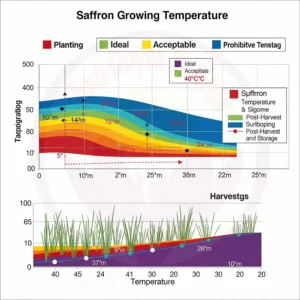
What is the best climate to grow saffron?
Table of Contents
Toggle- Climate: Saffron crocus prefers a Mediterranean climate with hot, dry summers and cool, wet winters.
- Soil: Saffron requires well-drained, sandy or loamy soil with a pH of 6-8.
- Sunlight: Saffron needs full sun to thrive.
We also review saffron climate requirements and saffron weather conditions, what climate saffron grows in, the climate for saffron, the best climate to grow saffron, saffron growing climate, and saffron temperature requirements, temperature for saffron cultivation, the temperature required for saffron cultivation, saffron temperature.
Saffron growing temperature
Saffron is a subtropical plant and grows well in places with mild winters and hot and dry summers. Saffron is highly resistant to cold, but because its growth period coincides with autumn, winter, and early spring, it naturally needs suitable and moderate weather.
For information on the exact price of saffron, you can check the Iranian saffron price Page or you can contact us via WhatsApp or our Contact us page. Also, you can visit our different packaging of saffron on our Buy saffron online page.
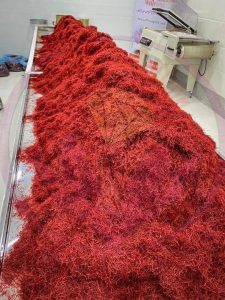
Scientific study about saffron growing temperature
This scientific study investigates how temperature affects flower formation in saffron (Crocus sativus L.). The research highlights optimal temperatures for flower initiation, the impact of corm storage conditions, and climate-related differences. The findings aim to improve saffron cultivation techniques by understanding the plant’s growth cycle and temperature requirements.
You can download this PDF to study the effects of temperature on flower formation in saffron (Crocus sativus L.). It provides detailed scientific research on optimal temperature conditions, corm management, and cultivation techniques to improve saffron flowering and yield.
During the period of dormancy or the rest of the plant (summer), rain or irrigation is harmful to it, so its cultivation is not common in Gilan and Mazandaran regions (these regions are humid parts of Iran) and warm regions of the south of the country. Therefore, it is not recommended to grow saffron at this time. Sunny and treeless lands that are also not exposed to cold winds are suitable to grow saffron. However, in some villages of Birjand and Qayen, it is planted under the shade of barberry bushes and almond trees, which are less irrigated in summer.
Also if you need to buy saffron in Bulk, please visit the referred page and if you need Saffron gift box, you may visit the linked page.
The maximum temperature of this plant is between 40 to 35 degrees Celsius(saffron climate requirements). At an altitude of 2000 to 2300 meters above sea level, it has shown good performance.
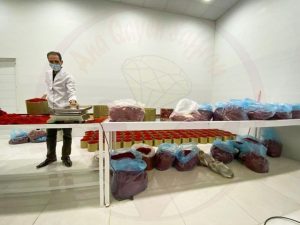
What climate does saffron grow in?
According to a study that was done in Khorasan province, it was shown that the saffron growing temperature has a noticeable effect on the flowering the saffron. They concluded that if the average temperature of summer and autumn increases by 2 degrees Celsius, the flowering of this plant will be significantly delayed. They showed that the saffron growing temperature is not noticeably affected by the change of temperature day and night.
According to the statistics, it was shown that the saffron weather conditions that change from location to location, highly affect the flowering of saffron. According to a 10-year-research on saffron growing temperature, it has been shown that the production of saffron has decreased over the increase of the average temperature. According to a simulated model to predict the flowering of saffron, the researchers have estimated that for an increase of 1 degree in saffron growing temperature, the flowering of saffron will be delayed up to 32 days.
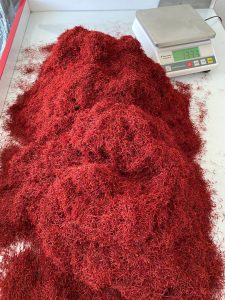
Best climate to grow saffron
The best climate to grow saffron and its effect on flowering the saffron have been proved by researchers [1]. The researchers also showed that the optimized saffron growing temperature for flowering is between 17, and 25 degrees and if the temperature is more than 30 degrees, the flowering will not take place [2].
The researchers reported that the best flowering was for those saffron bulbs that were kept for 90 to 100 days. The kesar plant temperature for these specimens was 25 degrees. Another group of researchers presented a model to simulate the optimized saffron growing temperature. Using this model they reported that the optimized climate for saffron is between 18 to 18.5 degrees and the maximum temperature is 22 degrees.
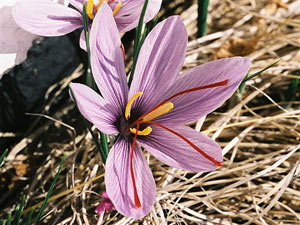
Suitable soil to grow saffron:
Since the saffron bulb stays in the ground for a relatively long time (7-5 years), the soil should be light or a mixture of sand and clay so that the bulb can withstand special regional conditions as well as provide food.
Therefore, to grow saffron and for the development of the plant and the production of a good and desirable product, fertile and drained lands without trees with soil (loamy, lemon, clay, and sandy) and calcareous with a pH between 7-8 are preferred to saline, poor and wetlands.
When you want to grow saffron you should pay attention that saffron does not produce well in soils that do not have rubble or weeds or rotted organic matter.
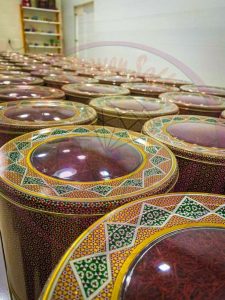
How to prepare the Land when you want to grow saffron:
When you want to grow saffron, the preparation of land is of great significance. In preparing the land to grow saffron, it is necessary to pay special attention. First, at suitable times in autumn or winter, the desired land is plowed deeply. If the conditions are not suitable or access to a tractor is not possible, plowing can be done in late spring or early July.
In traditionally preparing the land, in early spring, after the spring rains stop, the land is plowed with Iranian plows. After 10-15 days, the land is plowed again. If the land has clods, open the plow and crush the clods by trowel. After two or three weeks, they plow the land again twice in perpendicular directions. Before the third plowing, spread rotten animal manure. By doing this job, the land is partially cleared of weeds as well as the creation of a suitable substrate for cultivation.

In this way, the land is plotted and the length and width of the plots are determined by the slope of the land and the strength of the water. Usually, the width and length of the plots are between 10 *4 to 10 * 100 meters. In mechanized saffron cultivation, the land is plowed deeply in the autumn of the year before planting with a plow. In spring, after the spring rains stop, the soil is plowed moderately.
They remove the weeds. In August or September, after spreading 40-80 tons of animal manure and 200 kg of ammonium phosphate, they turn the land into a Faro and prepare it for cultivation. (Of course, nutritionists recommend that about 250 kg of potassium sulfate be mixed with the soil at this stage)
Bulb selection and saffron cultivation time:
When you want to grow saffron, one of the most important factors is the saffron bulb. Construction of new saffron farms is possible and common only with saffron bulbs. Therefore, preparing and selecting high-quality saffron bulbs for planting is important in creating and expanding cultivation. Saffron bulbs can be removed from the soil and transferred to another warehouse or farm. Based on the sleeping or resting time of saffron bulbs that lasts from late May to late August, bulbs can be taken out at this distance.
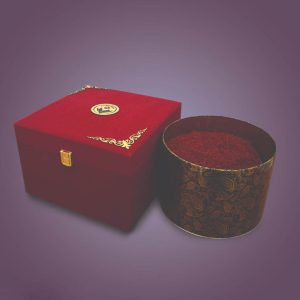
It is better to plant the bulbs after removing them from the ground so that the bulbs can be placed in the new soil while continuing to rest. Bulbs should be removed from late August onwards, as some bulbs may be ready for rooting and germination at this time. It can be stored in a cool and dry place with a height of 20-20 cm, but this causes a lack of physiological development of flowers and greatly reduces the yield in the first year of cultivation.
Saffron bulbs can be planted from the time of autumn (early June to mid-October, but it is better to avoid planting bulbs in late July and early August. Because at this time the air and soil are very hot and the moisture of the bulb may go away. According to research conducted by the Khorasan Industrial Research Center, the best time to plant is in June.
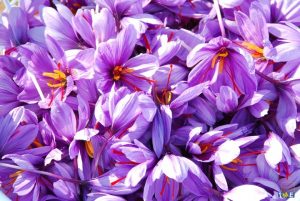
Type and amount of saffron bulb cultivation:
As mentioned, saffron is propagated by stem tubers, which are full bulbs and its size varies from hazelnut to walnut. Selected bulbs should be larger, healthier, free of wounds and scratches, and free of any disease.
To grow saffron, saffron bulbs should be disinfected with fungicides such as Sarzan, Tizan, and Gramnion, etc. in the ratio of 300-500 grams for 100 kg of bulbs against fungal diseases before planting. At the time of planting, it is better to separate the scales or dry layer of the bulb bottom with some free shell on the bulb so that the bulb absorbs water more easily and germinates faster. The amount of saffron bulb planting varies from 3 to 10 tons per hectare, depending on the size. Planting intervals are usually 30-25 cm on each side.
The number of saffron bulbs selected for planting in each hole is 3 with an average weight of 6 grams per bulb. If the saffron bulbs are planted individually in a row in Faro, at a distance of 8-6 cm from each other, 3 tons of bulbs are needed. If they are planted traditionally and 5 bulbs are used in each hole, the amount of bulb planting will reach 5 tons. It is worth mentioning that in the research, the best bulbs were bulbs with a size of more than 8 grams.

Saffron bulb planting operation:
To plant saffron bulbs, first, dig holes in a row with a shovel and put 3-15 bulbs inside each hole. The depth of saffron bulbs planting can be 15-20 cm and when planting the bulbs, the head should be facing up. Saffron bulbs at a depth of 20 cm in winter are protected from cold and frost and other environmental stresses and in summer from heat.
For planting saffron, 4-5 people participate in such a way that one person digs the holes with a shovel. Two people choose the bulbs in groups of 3 to 5 or 15 and the fourth person puts the bulbs inside the hole. The rest of the people continue to work until the whole land is planted. Finally, the uneven surface of the field is flattened with a shovel or trowel so that the saffron bulbs stick to the soil.
The cultivated land is left in the same way until the autumn irrigation. Before irrigation, about 20-10 tons of completely rotten animal manure is spread on the ground with a shovel.
Irrigation:
After planting saffron bulbs, which may last up to the end of September, the next parameter that is of great significance to growing saffron is irrigation. They irrigate the field about 15 to 10 days after planting. In different parts of Khorasan, depending on the climate of the region, saffron irrigation will start from mid-October to the first decade of November.
Because saffron flowering is somewhat dependent on the initial water so that the harvesting of saffron does not get difficult, the first water is divided between the parts with a distance of a few days so that the peak flowering period of the parts is not simultaneous.
The first water of saffron is very important and all parts of the land should be watered sufficiently and evenly so that the flowers of one piece come out at the same time. Soil breaking can be done by an Iranian plow. Breaking the soil makes the flower buds more easily emerge from the soil and grow strong and desirable.
After the first irrigation, 15-20 days later, the first saffron flowers appear. The saffron field does not produce significant yields in the first year. From early April until the leaves turn yellow, watering is done every 12-6 days.
It should be noted that after weeding, watering should be delayed so that the weeds are eliminated and do not re-emerge. The last water is effective in enlarging the onion.

Breaking:
As mentioned, after the first irrigation, as soon as the land is plowed, the surface of the field should be broken so that the saffron bulbs are not damaged.
Breaking makes the flowers come out of the soil easily and the animal manure mixes with the soil. In cases where the farmer has not been able to fertilize his land, before watering, the necessary fertilizer can be spread on the soil surface and mixed with the soil with surface plowing, and after this operation, they use the trowel to level the land and make the saffron bulbs stick to the soil.
Weeding:
Weeds reduce yields by competing with the saffron plant for water, nutrients, and sunlight. Therefore, this stage is very important to grow saffron properly. In addition, they may cause disturbances during the planting and harvesting of saffron and carry several diseases and insects, especially Nematodes. Field weeding is necessary whenever the weeds grow. The first wedding in the saffron fields is after the second irrigation, and this wedding will eliminate the weeds in the saffron field.
Normally, the first saffron weeding is done after the flowers are harvested and the second, if necessary, is done about a month before the third watering. Regarding chemical control of field weeds, it should be noted that since the effect of these herbicides on the plant has not been tested, the use of chemical herbicides should be avoided as much as possible when you want to grow saffron plants.
Operations to grow saffron more effectively:
Because it is not possible to improve the saffron plants through a change in inbreeding, so to increase the production efficiency and improve its quantity and quality, the following factors should be considered:
1) The land chosen for planting saffron should be fertile and rich in nutrients and organic.
2) Large and healthy saffron bulbs free from any disease and contamination should be selected for field cultivation.
3) Row work instead of pile work gives better results and simplifies machine operations inside the farm.
4) Use dried and protected saffron bulbs in dry, cool, and ventilated conditions.
5) Avoid watering the saffron plant during summer rest.
6) In planting saffron bulbs, be careful that in cold regions it is not 15-20 cm, and in temperate regions, it is not less than 15-10 cm.
7) Fight weeds as much as possible during summer dormancy.
8) As the saffron bulbs get closer to the soil surface every year, adding a layer equal to 2-3 cm of fertilizer, soil and ash causes more protection of saffron bulbs from environmental stresses, and at the same time more nutrients reach the plant.
9) When preparing the land, do not hesitate to add animal fertilizers along with the necessary chemical fertilizers, the amount and time of which have already been mentioned.
10) After irrigation, the soil needs to be broken so that the flowers can easily come out of the soil.
11) Fighting rodents, especially mice, is very important. Any negligence in this regard will destroy the crop and establish mice in the ground.
12) Harvesting flowers in the first hours of the day (4-9 in the morning) when the flowers are buds should be done.
13) Care should be taken in drying the flowers to preserve the pleasant color and aroma of saffron.
14) The best way to dry saffron is the tossing or Spanish drying method, which is done by the heater and refractory sieve.
15) Finally, saffron should be stored in containers in metal, tin, wood, or glass containers away from light, moisture, and heat.
In the rest of this paper, we will review some tips on growing saffron commercially. First, we will go for the summarized version for growing saffron and then, we will go for the full version. (These two parts are separated by red color) In this paper, we will review “How to grow saffron?”
Introduction
You should do the saffron planting in temperate climates. In preparing the land for planting, it is necessary that we pay special attention and accuracy. You can plant saffron from August to October.
How to grow saffron?
We can plant saffron in several ways. One of them is Armani planting
You can do this method in two ways:
• Normal Strip farming with a low density of 3 to 4 tons per hectare
• Armani farming with a density of 8 to 10 tons per hectare
Normal Strip farming
In this method, we dig a hole in the ground with a shovel or tractor to a depth of 25 to 30 cm. A few people start picking Crocus at a distance of 8 to 10 cm from each bulb. Then with a shovel or Tractor, we dig the next groove and transfer the soil of the new groove to the groove in which the saffron bulb is placed. The distance between each groove and the side groove is 30 to 40 cm. The average harvest in this method from the third year is 12. 15 kg per hectare.
Armani farming
This method is exactly the same as Normal Strip farming with a density of 3 to 4 tons per hectare, with the difference that the distance between the bulbs and the side bulbs is 4 to 5 cm. Besides, the distance between each groove and the side groove is 20 to 30 cm. Saffron bulb density per unit area is 8 to 10 tons per hectare. The average saffron harvest in this method from the third year is 20 to 25 kg per hectare.
Suitable climate for planting and growing saffron
Saffron is a tropical plant that we can grow well in areas with temperate climates, hot, dry, sunny summers, and relatively mild autumns and winters.
We should note that this may not be right in all circumstances, as the plant may adapt to the environment. For example in Hamedan, which is one of the oldest cities in Iran, saffron planting has satisfactory results.
The Saffron bulb is not active in summer, the period of awakening and activity is from November to May. Consequently, with the onset of the summer season, its leaves turn yellow and dry out, and it falls asleep.
As a result, hot and dry lands are good places where we can plant and grow.
The best type of soil for planting is sandy loam and clay with a small amount of lime.
The necessary temperature to grow the saffron
On average, we can plant in areas with a maximum temperature of 35 degrees Celsius. However, you may plant it at 40 degrees at an altitude of 2,850 to 2,850 meters above sea level.
How to irrigate
After planting saffron bulbs in the field, the field should be irrigated immediately. If the field has been irrigated before planting saffron, irrigation can be done a few days after planting. Saffron is a water-resistant plant. The first autumn irrigation should be done 15 days before the flower stems come out.
If watering is done before October and repeatedly, the leaves will appear first and then the flowers will appear, and in this case, picking the flowers will be difficult. Therefore, the flowers may remain between the leaves and will disappear.
We have reviewed “How to Grow Saffron” in this article (summarized version) and it’s done! Now, let’s go to the full version.
Growing saffron commercially, saffron cultivation, and saffron harvest
If you are fascinated by saffron, you are right. The taste, food, and medicinal properties, and most importantly income generation from the production and supply of saffron have attracted the attention of many people. Therefore, growing saffron commercially may be an interesting subject for readers.
Methods for growing saffron commercially and saffron cultivation?
Hydroponics method
The advantage of hydroponic methods over the traditional method for growing saffron and saffron cultivation is the prevention of wastage and as a result a very significant reduction in water consumption as well as cost reduction in land preparation, pest, and animal control, and weeds. It should be considered that setting up a greenhouse costs a lot at first, but over time, because of the return of capital compared to the traditional method, the initial cost is cost-effective. For information on the properties of saffron during pregnancy, you can refer to the article on the Benefits of saffron for pregnant women.
Land conditions for growing saffron and saffron cultivation
Growing saffron and saffron cultivation is recommended in sunny and treeless lands that are not exposed to cold winds, high temperatures in summers, and mild weather in winters. The maximum suitable temperature for this plant is 35 to 40 degrees Celsius and it has shown good performance at an altitude of 2,850 to 2300 meters above sea level (if you want more precise data on saffron growing temperature, you may read Saffron growing temperature article) However, saffron cultivation can be done in different conditions with different methods.
Because after a while, the saffron plant becomes accustomed to environmental conditions and gets used to them. Saffron cultivation and growing saffron in Iran is easy according to the ideal climatic conditions. For this reason, many people are looking to grow saffron commercially.
The saffron plant needs warm temperate climates for cultivation and is usually planted between August and October. The saffron growing season is from November to May. Indeed, it starts its activity in this period. Saffron leaves wither and wrinkle as the scorching heat begins.
It is at this time that the sleep of the saffron bulb begins and it practically ceases to function. Note that dry and warm soils are suitable for saffron cultivation and have priority. Land preparation is very important in growing saffron commercially and in fact, it is one of the most important stages of saffron cultivation. In cold seasons, it is better to prepare the ground by deep plowing.
If you do not have access to the tractor and plowing conditions at this time of year, you can postpone plowing until late spring or early summer (early July). Use a small amount of lime in the soil for saffron cultivation. Saffron bulbs remain in the ground for 5 to 7 years, so the soil should have light soil or a combination of sand so that saffron bulbs can withstand a long period of time for providing food as well as against specific regional conditions.
So that the saffron growing and saffron cultivations give better results and higher quality of saffron, fertile and drained lands without trees with loamy, lemon, clay, sandy, and calcareous soils with a pH between 8 to 7 on saline, poor and wet, acidic soils are preferred. Saffron does not produce good crops in lands that do not have rubble or weeds or rotted organic matter. In the process of saffron cultivation, plowing is done twice. In mechanized agriculture, plowing is usually the means of plowing the land.
This plowing is done in the autumn before saffron is planted. Again in the spring, after the spring rains have stopped, re-plowing is used to break the soil crust as well as kill the weeds. The soil should be sweet and saffron should be planted in a field that is about a few years after the last saffron cultivation of that land. Saffron cultivation gives better results if animal manure is used.
You should add this fertilizer to the soil in September or August with ammonium phosphate. This fertilizer should be injected into the ground by the Faro method. The best time for saffron cultivation is August to October.
After planting the saffron bulb in the ground for 4 to 7 years (although in some areas 10 years), it will yield. In addition, with these saffron bulbs, you will no longer need to extend the saffron cultivation to next year.
Growing saffron bulbs
Because saffron cultivation in new lands is only possible with saffron bulbs, careful selection is very important. Saffron bulbs can be removed from the soil and transferred to another warehouse or farm. Depending on the period of saffron bulbs’ sleep or rest, which lasts from late May to late August, saffron bulbs can be taken out at this distance.
It is best to plant the saffron bulbs after removing them from the ground so that they can continue to rest in the newly established soil. Saffron bulbs should be avoided from late August onwards, as some bulbs may be ready for rooting and germination at this time.
The shorter the distance between the bulbs and the planting time, the better. However, saffron bulbs are stored for several months in a cool, dry place with a height of 30 to 20 cm in a diffused form, but this prevents the physiological development of flowers and greatly reduces the yield of the first year of planting. It is better to avoid planting saffron bulbs in late July and early August because in these cases the air and the ground are very hot and there is a concern that the moisture of the saffron bulbs go away during transportation and may be damaged.
According to the Khorasan Industrial Research Center research, the best time for saffron cultivation and saffron bulbs is in June. You need a few people (4 to 5 people) to plant saffron. They make holes to start planting in a row of vessels. Put 3 to 15 saffron bulbs in each hole.
The required depth in these pits for planting saffron bulbs is equal to 15 to 20 cm (so that the cold and heat do not penetrate the saffron bulbs). When you want to put the saffron bulbs in the hole, the tip of the bulb (bulb head) should be facing up.
These four people work systematically to advance the saffron cultivation process. In such a way that the first person prepares the pit with a shovel for planting, the second and third people choose groups of 3 to 5 or 15 saffron bulbs, and the person who puts these saffron bulbs in the pit is definitely the fourth person. With this process, saffron cultivation can be completed in less time. After finishing, the uneven surface of the cultivated surfaces should be smoothed and compacted with a shovel. This compression and smoothing cause the saffron bulbs to stick to the soil. There is no need to do any other things on this land until the autumn irrigation.
Before watering, you should spray the animal manure in a completely rotten form on the soil surface. Cover the saffron grooves with a trowel. This will make your cultivation be in a row. You will need two tons of saffron bulbs per hectare for growing saffron. The saffron bulbs you choose for saffron cultivation should be perfectly healthy, free of corrosion and pests, and free of any disease. They should be young and not older than 7 years. When growing saffron, remove the mound and extra parts of the bulb.
Extra parts are the place of rooting in the bulb, which has become a dry wood. To protect saffron bulbs from pests, they should be soaked in mercury toxins such as granozal, tritizan, and sarzan. In general, for every 100 kg of bulbs, you need to consume 300 to 500 grams of animal manure. For growing saffron, you may plant two tons of bulbs per hectare. If these bulbs are not removed from the soil after the seventh year, they will become hollow and weak.
So that in 8 to 9 years, no trace of them will remain. The amount of bulbs that come out of the ground in year 7 after burying the bulbs is equal to 5 times the cultivation of the first year. The fertilizer for growing saffron plants should be animal and completely rotten. Note that you should not use fresh fertilizer for growing saffron plants under any circumstances. You need 30 to 50 tons of animal manure per hectare. This fertilizer should be injected into the soil along with phosphorus and potash (200 kg). In addition, every three years, 10 to 15 tons of animal manure with 100 kg of urea should be used.
These conditions are excellent and suitable for having farmland suitable for growing saffron. Irrigate only once from planting to saffron harvest. The soil should be watered immediately after growing saffron bulbs. If the ground for growing saffron is wet before planting bulbs, you should irrigate a few days after planting.
Saffron is resistant to drought and lack of water. The watering time of the saffron plant in autumn is 15 days after the stems are seen. If irrigation is done before the appearance of the stems and the month of October, the leaves will appear and then the saffron flowering will start this increase will cause many flowers to be out of our reach and will disappear between the leaves.
Especially if irrigation is repeated. Note that after watering the bulbs immediately after planting, the next watering stage is only once in the fall. Note that saffron is a drought-resistant plant and does not require much irrigation. Of course, (if you are looking for better efficiency for growing saffron in the next years) it is better to irrigate the ground several times after harvesting and collecting saffron in winter so that the bulbs in the soil become larger.
Irrigation for growing saffron and saffron cultivation
After planting saffron bulbs, which last until the end of September, they irrigate the field about 15 to 10 days after planting. In different parts of Khorasan, depending on the climate of the region, saffron irrigation will start from mid-October to the first decade of November. The flowering of saffron depends to some extent on the initial irrigation, so to avoid saffron harvest problems, the initial irrigation is divided between the plots at intervals of several days so that the flowering period of the plots does not coincide with each other.
Initial irrigation of saffron is very important in growing saffron and all parts of the land should be watered sufficiently and evenly so that the flowers of one piece come out at the same time. After the farm is plowed, they use an Iranian plow to break the soil crust and then trowel the ground. Breaking the soil crusts is very important in growing saffron and causes the saffron flower buds to come out of the soil more easily and have strong and desirable growth.
After the initial irrigation, the first saffron flowers appear 20 to 15 days later. Obviously, the saffron field does not produce significant yields in the first year (yet it doesn’t mean that the growing saffron process has not been correct. Because this is normal.) Watering is done every 12 to 6 days from early April until the leaves turn yellow. After weeding, watering should be delayed so that the weeds are removed and do not re-emerge. The last irrigation is very effective in enlarging the saffron bulbs.
saffron cultivation and breaking the soil crusts
When you do the first irrigation, you will encounter a soil crust on the ground. In growing saffron, you should not postpone the breaking of the soil crust and it is better to break this crust by plowing the ground with a grooved shovel, Iranian plow, cultivator, and tilting shovel.
Breaking the soil layer makes saffron flowers easily protrude from the soil and animal manure is well distributed in the ground thus the saffron growing process will be more efficient. If your land has not yet received the necessary fertilizer by the time of autumn irrigation, it is better to sprinkle the necessary fertilizer on the ground surface of saffron and mix it with the soil before watering.
This is almost the same as breaking the chain. To smooth the ground and fix the soil to saffron bulbs, they use a trowel on the soil. If the saffron harvest is over, you should weed it. Weeding should be done after harvesting the flowers. Weeds reduce the growth of the saffron plant and remove many nutrients, sunlight, and water from its reach. These weeds provide the basis for any insects, pests, and diseases.
Field weeding is essential whenever weeds grow In saffron soils, weeding is usually done after the second irrigation. Weeds are cleaned after collecting saffron flowers. The second time to eradicate saffron weeds is one month before the third irrigation. It is better not to use chemical herbicides during the growth of saffron plants.
Saffron harvest
You need 15 to 25 days for saffron harvest. Your land crop is very low in the first year and is limited to large bulbs with adequate food storage. In mid-November, purple saffron flowers appear in their fields. With the appearance of purple flowers, the saffron harvest begins and continues for 3 weeks.
Saffron harvest begins before sunrise and lasts until 9 am. The colorful flowers of saffron are purple and show a beautiful image when the cold season starts. The saffron harvest season is very beautiful in Iran and we invite you to visit during this season.
When the saffron harvest starts in the cities where the saffron is the people’s main job, nearly all the people are involved in that. When the sun rises, you can see many people heading towards the saffron fields for saffron harvest.
Are you able to send saffron via Dubai?
We are able to send saffron from Dubai to anywhere in the world. For big orders, LC is also possible via Dubai. In order to order saffron please be in touch with us via WhatsApp or email.
About Ana Qayen saffron
Many people are looking for a place where they can buy saffron. We are a supplier of Iranian saffron and if you want to buy saffron, you have come to the right place. Our saffron is harvested from the city of Qayen in Iran, one of the most famous cities for the quality of saffron. This city is known as the city of saffron in Iran.
To buy saffron online, you may visit our Buy saffron online page.
We also have another branch in Lyon, France, which makes it very easy for you to order in Europe. For information on the exact price of saffron, you can contact us through the Contact us page or WhatsApp.

When you want to purchase saffron, you should be sure about the quality of the saffron that you are buying. Our saffron has got a European certificate from SAI CHIMIE lab which is one of the most famous labs in Europe.
Also, our saffron is packaged in different and luxurious packages. You can see our different packing below. You can buy saffron with these packages in our online shop.
You can also find us on social media via Instagram, Facebook, Linkedin, Pinterest, and Youtube.










What are the saffron climate requirements, and how do these conditions influence the overall growth, yield, and quality of the saffron threads?
Saffron climate requirements include hot, dry summers and cold winters. These conditions help the saffron corms rest and bloom properly. Meeting the right saffron climate requirements ensures better growth, higher yield, and rich color and aroma in the saffron threads.
What climate does saffron grow in, and why is this particular environment crucial for its successful cultivation and high-quality yield?
Saffron thrives best in a semi-arid climate with hot summers and cold winters. So, if you’re asking what climate does saffron grow in, this specific weather is ideal for high-quality yield.
sr in july june august temprature is 35 is it safe weather for safran
Yes, temperatures around 35°C in June to August are generally safe for storing saffron if it’s kept in a cool, dry, and dark place. Direct sunlight and humidity should be avoided to preserve its quality.
Hi. Thanks for your useful article. I need price of saffron in Nepal.
Hello. You’re welcome. Please check the Kesar price in Nepal article.
What are the benefits of saffron tea?
Please refer to the benefits of saffron tea article.
Hello. Can i use saffron while breastfeeding?
Hello yes. Please visit the Saffron while breastfeeding article.
How to buy saffron in the United States of America?
Pls send me the saffron growing conditions.
where does saffron grow best? Thx
saffron growing requirements
I need information about saffron climate?
What is the saffron climate?
I want to grow saffron in canada. Is it possible?
What are the conditions to grow saffron?
What is the best climate for saffron?
What is the kesar plant temperature?
What are the conditions for growing saffron?
Is it possible for growing saffron in canada?
What is the saffron climate requirements?
Is growing saffron in usa possible?
Need some info about saffron climate conditions. Thx in advance
What is the best climate for saffron?
What is the saffron growing conditions?
Need info about climate to grow saffron. Thx
Can you tell me what climate does saffron grow in?
What climate does saffron grow in?
I need to know abot the saffron temperature requirements.
What is the best climate to grow saffron?
What is the temperature for saffron cultivation?
What is the saffron weather conditions?
Great job on this information.
Saffron weather conditions is a very important step to learn
I want to know about the saffron growing climate
What is the saffron growing climate?
Can you tell me the temperature required for saffron cultivation?
What is the temperature required for saffron cultivation?
Nice information about saffron temperature. Thx a lot
What should be the saffron temperature when planting?